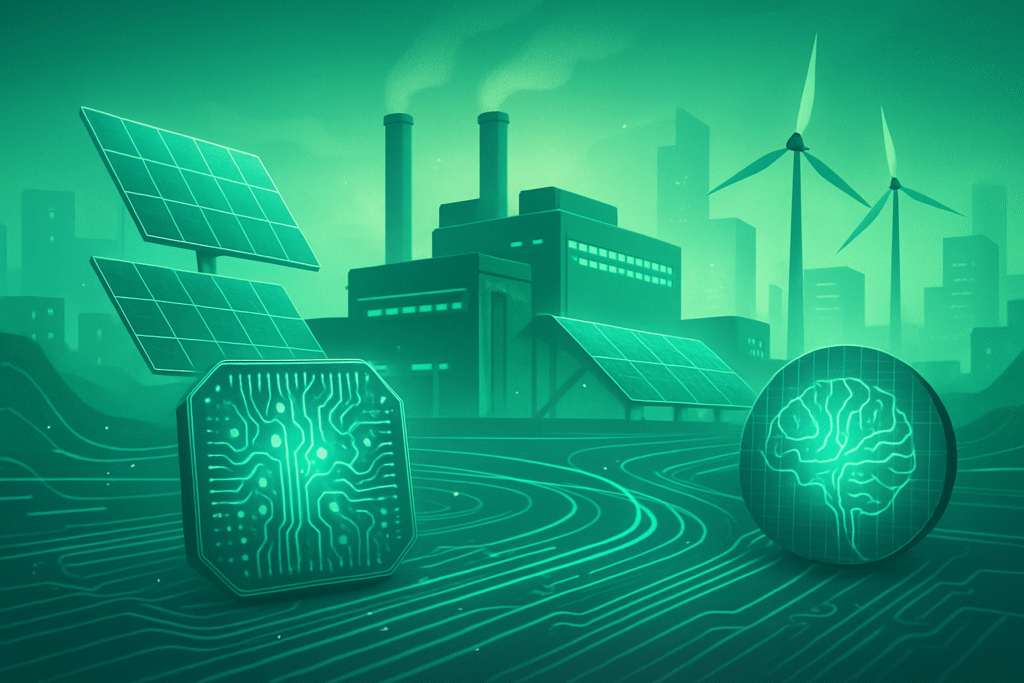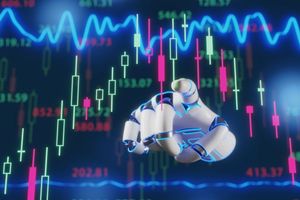
The relentless march of artificial intelligence (AI) is pushing the boundaries of computational power, demanding ever more sophisticated semiconductors. Yet, this technological acceleration comes with a profound environmental cost. The semiconductor industry, a foundational pillar of the digital age, is now at a critical inflection point, grappling with its substantial ecological footprint. A burgeoning movement towards sustainability and green initiatives is rapidly transforming the entire semiconductor production process, from raw material sourcing to manufacturing and waste management. This shift is not merely an ethical choice but a strategic imperative, driven by escalating regulatory pressures, growing consumer demand for eco-conscious products, and the inherent economic benefits of resource efficiency. The immediate significance of these green endeavors is clear: to mitigate the industry's massive energy and water consumption, reduce greenhouse gas (GHG) emissions, and minimize hazardous waste, ensuring that the very building blocks of AI are forged responsibly.
This comprehensive embrace of sustainable practices is poised to redefine the future of technology, intertwining environmental stewardship with technological advancement. As the world races to unlock AI's full potential, the industry's commitment to greener manufacturing processes is becoming paramount, addressing pressing climate concerns while simultaneously fostering innovation and enhancing long-term resilience.
Engineering a Greener Chip: Technical Innovations Driving Sustainable Production
Historically, semiconductor manufacturing has been a resource-intensive behemoth, characterized by immense energy consumption, prodigious water use, and the generation of hazardous waste and potent greenhouse gases. Today, a paradigm shift is underway, propelled by technical innovations that fundamentally alter how chips are made. These modern approaches represent a radical departure from older, less sustainable methodologies.
One of the most critical areas of transformation is advanced water recycling. Semiconductor fabrication demands vast quantities of ultrapure water (UPW) for cleaning and rinsing wafers. A single 200-mm wafer can consume over 5,600 liters of water, with large fabs using up to 10 million gallons daily. Modern green initiatives employ sophisticated multi-stage recycling systems, including advanced Reverse Osmosis (RO) filtration, Ultra-filtration (UF), and electro-deionization (EDI), which can reduce chemical usage by over 95% compared to conventional ion exchange. Treated wastewater is now often repurposed for less demanding applications like cooling towers or exhaust scrubbers, rather than simply discharged. Companies like GlobalFoundries (NASDAQ: GFS) have announced breakthroughs, achieving up to a 98% recycling rate for process water, a stark contrast to older methods that relied heavily on fresh water withdrawal and less sophisticated wastewater treatment.
Concurrently, the industry is making significant strides in Greenhouse Gas (GHG) emission reduction. Semiconductor processes utilize high Global Warming Potential (GWP) fluorinated compounds such as perfluorocarbons (PFCs) and nitrogen trifluoride (NF3). Green strategies involve a hierarchy of actions: reduce, replace, reuse/recycle, and abate. Process optimization, such as fine-tuning chamber pressure and gas flow, can reduce GHG consumption. More importantly, there's a concerted effort to replace high-GWP gases with lower-GWP alternatives like fluorine (F2) or carbonyl fluoride (COF2) for chamber cleaning. Where replacement isn't feasible, advanced abatement technologies, particularly point-of-use (POU) plasma and catalytic systems, capture and destroy unreacted GHGs with efficiencies often exceeding 99%. This is a significant leap from older practices where a higher proportion of unreacted, high-GWP gases were simply vented, and abatement technologies were less common or less effective.
Furthermore, renewable energy integration is reshaping the energy landscape of fabs. Historically, semiconductor manufacturing was powered predominantly by grid electricity derived from fossil fuels. Today, leading companies are aggressively transitioning to diverse renewable sources, including on-site solar, wind, and even geothermal solutions. This is complemented by advanced energy management systems, intelligent microgrids, and the application of AI and Machine Learning (ML) to optimize real-time energy consumption and predict maintenance needs. The shift to Extreme Ultraviolet (EUV) lithography also plays a role, as it eliminates many multi-patterning steps required by older Deep Ultraviolet (DUV) methods, significantly lowering energy consumption per wafer. These efforts collectively aim for net-zero emissions and 100% renewable energy targets, a stark contrast to the fossil fuel reliance of the past.
Finally, the adoption of circular economy principles is transforming material usage and waste management. This involves eco-design for products, ensuring durability, repairability, and ease of material extraction at end-of-life. Material recovery and reuse are paramount, with innovations in remanufacturing parts, recycling silicon wafers, and recovering critical raw materials (CRMs) like gallium and precious metals from processing waste. Older methods often followed a linear "take-make-dispose" model, leading to significant waste and heavy reliance on virgin raw materials. The circular approach seeks to decouple growth from resource consumption, minimize landfill waste, and create closed-loop systems for materials, driven by customer awareness, regulatory demands, and the critical business imperative for supply security.
Corporate Green Giants: Reshaping the Semiconductor Landscape
The imperative for sustainable semiconductor manufacturing is not just an environmental mandate; it's a powerful force reshaping competitive dynamics and market positioning across the tech industry. Major players are not only investing heavily in green initiatives but are also leveraging them as strategic differentiators.
Intel (NASDAQ: INTC) stands out with an ambitious holistic approach, aiming for net-zero greenhouse gas emissions across Scope 1 and 2 by 2040 and Upstream Scope 3 by 2050. The company already utilizes 99% renewable energy in its global operations and is striving for zero waste to landfill by 2030, having reached 6% by 2023. This commitment enhances its brand reputation and appeals to environmentally conscious customers and investors. Taiwan Semiconductor Manufacturing Company (TSMC) (NYSE: TSM), the world's largest dedicated independent semiconductor foundry, has committed to 100% renewable energy by 2050 and is a leader in water reclamation and recycling. Their pledge to reach net-zero emissions by 2050 sets a high bar for the industry, influencing their vast network of customers, including major AI labs and tech giants.
Other significant players like Samsung (KRX: 005930) are focused on developing low-power chips and reducing power consumption in customer products, having achieved "Triple Standard" certification for carbon, water, and waste by Carbon Trust. NVIDIA (NASDAQ: NVDA) reported that 76% of its global production energy came from renewable sources in 2023-2024, reflecting a broader industry trend. onsemi (NASDAQ: ON), recognized as a leader in semiconductor sustainability, aims for net-zero emissions by 2040 across all scopes, with approved science-based emission reduction targets. These companies stand to benefit from enhanced market position, significant cost savings through improved operational efficiency, and reduced risks associated with tightening environmental regulations.
The shift towards green semiconductor manufacturing presents both opportunities and disruptions for major AI labs, tech giants, and startups. The explosive growth of AI is driving a surge in energy consumption, making energy-efficient AI chips a critical demand. Tech giants like Apple (NASDAQ: AAPL), Microsoft (NASDAQ: MSFT), and Daimler (ETR: MBG) are committed to achieving net-zero supply chains by specific deadlines, creating immense pressure on semiconductor suppliers to adopt sustainable practices. This influences procurement decisions, potentially favoring green-certified manufacturers and driving demand for specialized low-power AI processing architectures from innovative startups like Green Mountain Semiconductor.
Furthermore, the focus on supply chain resilience and sustainability is leading to geopolitical shifts. Initiatives like the U.S. CHIPS for America Act and the EU Chips Act are investing heavily in local, advanced, and energy-efficient semiconductor production. This aims to secure access to chips for AI labs and tech giants, reducing dependency on volatile external supply chains. While offering stability, it could also introduce new regional supply chain dynamics and potentially higher costs for some components. Paradoxically, AI itself is becoming a critical tool for achieving sustainability in manufacturing, with AI and ML optimizing fabrication processes and reducing waste. This creates opportunities for startups developing AI-powered solutions for green manufacturing, though high initial investment costs and the challenge of finding sustainable materials with comparable performance remain significant hurdles.
A Greener Future for AI: Wider Significance and Global Impact
The wider significance of green initiatives in semiconductor production within the broader AI landscape is profound and multi-layered. It addresses the critical environmental challenges posed by AI's surging demand while simultaneously fostering innovation, economic competitiveness, and geopolitical stability.
At its core, green semiconductor manufacturing is crucial for mitigating AI's environmental footprint. The production of a single high-end GPU can generate approximately 200 kg of CO₂, equivalent to driving a gasoline car over 800 miles. Without sustainable practices, the environmental cost of AI could escalate dramatically, potentially undermining its societal benefits and global climate goals. By optimizing resource consumption, minimizing chemical waste, and lowering energy use during production, these initiatives directly combat the ecological burden of AI. Furthermore, they contribute to enhancing resource security and a circular economy by reducing reliance on scarce raw materials and promoting reuse and recycling, bolstering supply chain resilience against geopolitical risks.
This movement also aligns closely with broader environmental movements, particularly the principles of the circular economy, which aims to design out waste and pollution, keep products and materials in use, and regenerate natural systems. This echoes calls for systemic changes beyond mere "reduction" towards "rethinking" entire product lifecycles. Compared to early AI milestones, which had minimal environmental footprints due to lower computational demands, today's AI, with its unprecedented energy and resource requirements, has brought environmental costs to the forefront. The dramatic increase in computing power required for cutting-edge AI models (doubling every 3.4 months since 2012) highlights a critical difference, making green manufacturing a direct response to this accelerated environmental toll.
However, potential concerns persist. The "bigger is better" attitude in the AI community, focusing on increasingly large models, continues to drive a massive surge in energy consumption. Data centers, the backbone of AI, are projected to increase their electricity use significantly, with some estimates suggesting a 300% increase in CO2 emissions from AI accelerators alone between 2025 and 2029. This exacerbated energy demand from AI growth challenges even the most aggressive green manufacturing efforts. The specialized nature and rapid advancement of AI hardware also contribute to a growing e-waste and obsolescence problem. Moreover, a noted lack of transparency regarding the full environmental impact of AI development and utilization means the actual emissions are often underreported, hindering accountability.
In a powerful paradox, AI itself is becoming a tool for green manufacturing. AI and ML can optimize product designs, model energy consumption, monitor equipment for predictive maintenance, and manage water usage in real-time, potentially reducing a fab's carbon emissions by about 15%. This dual nature—AI as both an environmental burden and a solution—contrasts with earlier technological advancements where environmental impacts were often an afterthought. The current focus on green semiconductor manufacturing for AI is a crucial step towards ensuring that the technological progress powered by AI is not achieved at an unsustainable environmental cost, but rather contributes to a more sustainable future.
The Horizon of Green Silicon: Future Developments and Expert Outlook
The trajectory of green semiconductor manufacturing is set for transformative change, balancing the escalating demand for advanced chips with an unwavering commitment to environmental responsibility. Both near-term and long-term developments will play a crucial role in shaping this sustainable future.
In the near-term (1-5 years), expect accelerated integration of renewable energy sources, with major chipmakers pushing to meet substantial portions of their electricity needs from clean power by 2026. Stricter water usage regulations, particularly from regions like the European Union, will drive widespread adoption of advanced water recycling technologies, aiming for even higher recycling rates than the current breakthroughs. Increased collaboration between chipmakers and designers will focus on energy-efficient chip architectures, incorporating low-power transistors and power-gating technologies. Furthermore, green chemistry will see more widespread implementation, replacing harmful chemicals with safer alternatives, and sustainable material sourcing will become a standard practice, with companies like Intel (NASDAQ: INTC) partnering with suppliers committed to responsible mining and recycled content.
Looking to the long-term (5-10+ years), the industry is targeting ambitious goals like net-zero greenhouse gas emissions and 100% carbon-neutral power by 2050, as set by companies such as TSMC (NYSE: TSM) and GlobalFoundries (NASDAQ: GFS). Significant research will explore new, sustainable materials beyond traditional silicon, such as organic semiconductors and perovskites, to enable even more energy-efficient AI. Wide-bandgap materials like Gallium Nitride (GaN) and Silicon Carbide (SiC) will become more prevalent in power electronics, enhancing efficiency in renewable energy systems and electric vehicles. The true realization of circular economy approaches, with chips designed for disassembly and advanced recycling methods for critical raw material recovery, will be key. Experts also predict the increasing integration of green hydrogen for fabrication processes and the potential for nuclear-powered systems to meet the immense energy demands of future AI-driven fabs.
Potential applications for these green semiconductors are vast. They are integral to Electric Vehicles (EVs), enabling efficient power electronics for charging, motor control, and energy management. They are vital for renewable energy systems like solar cells and smart grids, maximizing energy harvest. In data centers and cloud computing, green semiconductors with low-power processors and optimized circuit designs will drastically reduce energy consumption. Furthermore, innovations like organic semiconductors promise significantly lower power consumption for AI accelerators and edge computing devices, enabling more distributed and sustainable AI deployments.
However, significant challenges persist. The high energy consumption of semiconductor manufacturing remains a hurdle, with fabs still consuming vast amounts of electricity, often from fossil fuels. Water usage and contamination continue to strain local supplies, and the management of chemical waste and pollution from hazardous substances like hydrofluoric acid is an ongoing concern. The growing volume of e-waste and the difficulty of recovering rare metals from old components also demand continuous innovation. The complexity of the global supply chain makes tracking and reducing Scope 3 emissions (indirect emissions) particularly challenging. Experts predict that carbon emissions from semiconductor manufacturing will grow at 8.3% through 2030, reaching 277 million metric tons of CO2e, driven largely by AI. This "AI Supercycle" is creating an "energy supercycle" for data centers, necessitating significant investments in sustainable energy solutions and more energy-efficient chip designs. Paradoxically, AI and ML are seen as pivotal tools, optimizing product designs, processes, and accelerating the discovery of new sustainable materials through AI-powered autonomous experimentation (AI/AE). The future demands a relentless pursuit of both green manufacturing for AI and AI for green manufacturing.
A Sustainable Silicon Future: Charting the Path Forward
The semiconductor industry is undergoing a profound transformation, driven by the dual pressures of unprecedented demand, particularly from the burgeoning Artificial Intelligence (AI) sector, and an urgent imperative to address its significant environmental footprint. Green initiatives are no longer peripheral but have become strategic cornerstones, redefining how chips are designed, produced, and managed across their entire lifecycle.
The key takeaways from this green revolution are clear: a multi-faceted approach encompassing aggressive renewable energy integration, advanced water conservation and recycling, stringent waste reduction through circular economy principles, the adoption of green chemistry and sustainable materials, and the pivotal leveraging of AI and Machine Learning for process optimization. Major players like Intel (NASDAQ: INTC), TSMC (NYSE: TSM), and Samsung (KRX: 005930) are leading the charge, setting ambitious net-zero targets and investing heavily in sustainable technologies.
The significance of this development in AI history is dual-faceted and profound. On one hand, AI's insatiable demand for computational power and advanced chips presents an enormous environmental challenge, threatening to escalate global energy consumption and carbon emissions. On the other, AI itself is emerging as an indispensable tool for achieving sustainability in semiconductor manufacturing, optimizing everything from design to resource utilization. This symbiotic relationship underscores that sustainable chip production is not merely an ethical add-on, but a foundational requirement for the long-term viability and ethical development of AI itself. Without greener silicon, the full promise of AI could be overshadowed by its ecological cost.
Looking ahead, the long-term impact promises a redefinition of industrial responsibility. Sustainability is evolving beyond mere compliance to become a primary driver of innovation, competitiveness, and new revenue streams. The industry is moving towards a true circular economy, ensuring that the foundational components of our digital world are produced with environmental stewardship at their core. This "green revolution" in silicon is crucial not just for the semiconductor sector but for enabling a greener future across countless other industries, from electric vehicles to renewable energy systems.
What to watch for in the coming weeks and months will be crucial indicators of this ongoing transformation. Keep a close eye on further policy and funding developments, especially from initiatives like the U.S. CHIPS for America program, which is increasingly emphasizing AI's role in sustainable chip manufacturing. Expect more detailed progress reports from leading semiconductor companies on their net-zero targets, renewable energy adoption rates, and water recycling achievements. Look for emerging technology demonstrations, particularly in 3D integration, wide bandgap semiconductors like Gallium Nitride, and the real-time AI/ML optimization of fabrication processes. Increased supply chain transparency and collaboration, driven by the focus on reducing Scope 3 emissions, will also be a key area to monitor, alongside evolving regulatory pressures from bodies like the European Union. These developments will collectively chart the path towards a truly sustainable silicon future, ensuring that the innovations powering our world are built on an environmentally responsible foundation.
This content is intended for informational purposes only and represents analysis of current AI developments.
TokenRing AI delivers enterprise-grade solutions for multi-agent AI workflow orchestration, AI-powered development tools, and seamless remote collaboration platforms.
For more information, visit https://www.tokenring.ai/.








